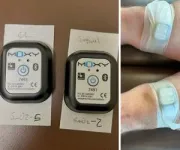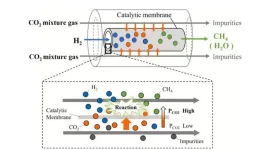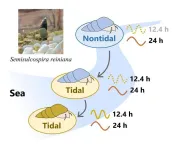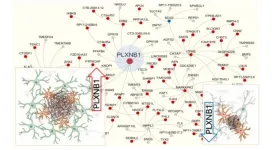(Press-News.org) Of the many perils facing members of the military, injuries incurred in training or on deployment repeatedly sideline elite operators.
“It’s a pervasive problem,” says Dhruv Seshadri, an assistant professor of bioengineering in Lehigh University’s P.C. Rossin College of Engineering and Applied Science. “We’re looking at how we can integrate physiological data, biomechanical data, and subjective assessments to help reduce the risk of these injuries happening in the first place, and when they do happen, how we can use those data to accelerate the soldier’s return to operation.”
Seshadri is part of a collaborative, interdisciplinary team that recently received funding from Lehigh University to mitigate musculoskeletal injuries in the military population. Seshadri will work in tandem with Robert Kaleal, director of performance at Spire Academy in Ohio and CEO of Bodies Done Right, and with the FBI and its new recruits to the bureau’s Hostage Rescue Team (HRT).
The recruits endure a rigorous 10-month training period at the New Operator Training School (NOTS) in Quantico, Virginia. The training involves intense physical challenges, with the operators wearing smartwatches and sweat patches that monitor the effects of these demanding exercises.
However, the FBI isn’t currently using the data for performance optimization, says Seshadri.
“We plan to monitor the operators using a suite of wearable sensors that will also measure heart rate, respiratory rate, body temperature, heart rate variability, muscle oxygen saturation, and total hemoglobin levels,” he says. “We’ll combine those daily data with subjective assessments that we’ll get when we go to Quantico at discrete time points during the project. We’ll analyze the data, and develop algorithms that we’ll pass on to our partners at Spire Academy and Bodies Done Right, who will develop individualized training plans for each operator based on those algorithms.”
Seshadri and his team will analyze each operator’s day-to-day data based on the context within which they’re performing at any given time—navigating an obstacle course, swimming, rappelling from helicopters, and so on. They’ll compare those to other data points collected from that individual, as well as to information gathered from other individuals within the program.
“Take heart rate variability, for example. We can look at how hard someone is working from a cardiovascular adaptation standpoint, and we can see how that fluctuates over time. We can also examine how that compares to other NOTs who are doing the same activities.”
The researchers will also examine whether the physiological data correlates with errors in decision-making made during training sessions. The data could reveal that illness or injury is preventing the person from performing optimally.
Additionally, the researchers are leading efforts for the FBI HRT team to utilize wearable technology to guide rehabilitation of the operators following injuries such as torn anterior cruciate ligament (ACLs) or torn patellar tendons. Seshadri and Amitrano recently returned from Quantico having used technologies such as the Moxy and Polar devices to assess changes in muscle physiology and cardiac deconditioning in operators currently rehabbing back from significant time-loss injuries.
“We’ll collect the data and integrate it into a green-yellow-red stratification based on severity,” says Seshadri. “We’ll pass that information along to our colleagues at SPIRE and Bodies Done Right who can then prescribe operator-specific workout plans or rehab plans based on science. If the person is healthy, they can focus on training optimization. If the person is injured, having access to the data around an operator’s baseline healthy state will help guide our partners in determining how much and how quickly they should increase that person’s workload so they can return to duty healthy.”
It’s a truly unique collaboration, he says, one that integrates military performance, sports performance, and bioengineering. The project is also novel in how it treats data, which can oftentimes be so complex that the information is useless to the end user. Seshadri says he and his team did extensive group analysis to determine what their end users—in this case, their colleagues at Spire—want to see in the data and why.
“We incorporated what we learned and leveraged machine learning and artificial intelligence to distill the data and create predictive trends that are understandable—and actionable.”
For Seshadri, the project represents an opportunity to give back to those serving our country that’s profoundly fulfilling. It’s also an exciting time for the students in his lab.
“It’s really powerful seeing their enthusiasm for this research,” he says. “They’re constantly bringing up new ideas and sharing their data with each other, and it’s that kind of collaborative mindset that fuels creativity, and ultimately, improves outcomes for those people we’re trying to help.”
Related Links
Rossin College Faculty Profile: Dhruv Seshadri
Spire Academy: Robert Kaleal
Lehigh University: Department of Bioengineering END
Bioinformatics approach could help optimize soldiers’ training for improved readiness and recovery
In collaboration with the FBI and Spire Academy, Lehigh University bioengineering researcher Dhruv Seshadri and Bioengineering PhD student Joseph Amitrano to develop algorithms to analyze data for personalized training plans
2024-05-27
ELSE PRESS RELEASES FROM THIS DATE:
Earth scientists describe a new kind of volcanic eruption
2024-05-27
No two volcanic eruptions are exactly alike, but scientists think a series of explosive eruptions at Kīlauea volcano fit into a whole new category.
By analyzing the dynamics of 12 back-to-back explosions that happened in 2018, researchers describe a new type of volcanic eruption mechanism. The explosions were driven by sudden pressure increases as the ground collapsed, which blasted plumes of rock fragments and hot gas into the air, much like a classic stomp-rocket toy.
Researchers from the University of Oregon, United States Geological Survey and China’s Sichuan University report their findings in a paper published May 27 in Nature Geoscience.
The ...
Warmer wetter climate predicted to bring societal and ecological impact to the Tibetan Plateau
2024-05-27
While recent reports have stated that more than half the world’s largest lakes, including lakes in the Tibetan plateau, are drying up, a paper in Nature Geoscience today (27/5/24 DOI 10.1038/s41561-024-01446-w ) suggests that, by the end of this century, land-locked lakes on the Tibetan Plateau are set to increase exponentially, resulting in major land loss and related economic, environmental and climatic impacts.
Climate and weather predictions suggest that increased rainfall due to climate change will enlarge these lakes, and see water levels rise by up to 10 metres.
The volume of water caught in these land-locked lakes is estimated to ...
Feeding infants peanut products protects against allergy into adolescence
2024-05-27
Feeding children peanuts regularly from infancy to age five reduced the rate of peanut allergy in adolescence by 71%, even after many years when the children ate or avoided peanut as desired.
The new findings provide conclusive evidence that introducing peanuts into babies’ diets early will achieve long-term prevention of peanut allergy.
Lead investigator Professor Gideon Lack from King’s College London said: “Decades of advice to avoid peanuts has made parents fearful of introducing peanuts at an early age. The evidence is clear that early introduction of peanut in infancy ...
Who will like beetle skewers? What Europeans think about alternative protein food
2024-05-27
Why do people in Paris like seaweed and tofu salad? Will Italians be tempted to try a beetle skewer? How many young Polish consumers are "food innovators", eager to eat chickpea pâté? In an international project, researchers from SWPS University analysed European consumers' attitudes towards alternative protein food products.
In the face of the fight against climate change, more and more people are modifying their diets, giving up or limiting conventional sources of protein (e.g., beef, pork, poultry, and animal dairy) in favour of those with a lower environmental impact. These are the so-called alternative protein food (APF) products, which may be based on ...
ETRI wins ‘iF Design Award’ for mobile collaborative robot
2024-05-27
ETRI research team has won a main prize at the German International Design Competition, one of the top three design award competitions in the world. This signifies global recognition of our research team’s technology.
Electronics and Telecommunications Research Institute (ETRI) announced that its Teach Pendant software for the autonomous mobile collaborative robot (MOBY1)) won the main prize in the User Experience (UX2)) category at the ‘iF Design Award 20243)’, an international design competition in Germany.
1) MOBY: Equipped with the AI-based vision solution ‘IndyEye’ and the ...
Combating carbon footprint: novel reactor system converts carbon dioxide into usable fuel
2024-05-27
Reducing carbon emissions from small-scale combustion systems, such as boilers and other industrial equipment, is a key step towards building a more sustainable, carbon-neutral future. Boilers are widely used across various industries for essential processes like heating, steam generation, and power production, making them significant contributors to greenhouse gas emissions.
Boilers are generally quite efficient. As a result, it is difficult to reduce CO2 emissions simply by improving the combustion efficiency. Therefore, researchers are exploring alternative approaches to mitigating the environmental ...
Investigating the origin of circatidal rhythms in freshwater snails
2024-05-27
Organisms, including humans, follow a schedule that coordinates important bodily functions such as sleep-wake cycles, metabolism, hormone production, cognitive function, and feeding habits to environmental cycles. While most organisms possess circadian rhythms synchronized with the 24-hour day-night cycle, they have also developed other internal clocks to suit their local environments. Marine animals have evolved circatidal rhythms, aligning activities with the 12.4-hour tidal cycle, complementing circadian rhythms.
Researchers from Chiba University have discovered that snails living in downstream tidal areas have biological ...
Altering cellular interactions around amyloid plaques may offer novel Alzheimer’s treatment strategies
2024-05-27
New York City, [May 27, 2024] – Researchers at the Icahn School of Medicine at Mount Sinai have made a significant breakthrough in Alzheimer’s disease research by identifying a novel way to potentially slow down or even halt disease progression. The study, which focuses on the role of reactive astrocytes and the plexin-B1 protein in Alzheimer's pathophysiology, provides crucial insights into brain cell communication and opens the door to innovative treatment strategies. It was published in Nature Neuroscience (DOI 10.1038/s41593-024-01664-w) on May 27.
This groundbreaking work is centered ...
Brain damage reveals part of the brain necessary for helping others
2024-05-27
Our willingness to help others is governed by a specific brain region pinpointed by researchers in a study of patients with brain damage to that region.
Learning about where in the brain ‘helping’ decisions are made is important for understanding how people might be motivated to tackle large global challenges, such as climate change, infectious disease and international conflict. It is also essential for finding new approaches to treating disorders of social interactions.
The study, ...
Surprising properties of elastic turbulence discovered
2024-05-27
Blood, lymph fluid and other biological liquids can have surprising and sometimes troubling properties. Many of these biological solutions are non-Newtonian fluids, a type of liquid that is characterized by a non-linear relationship between stress and strain. Consequently, non-Newtonian fluids don’t necessarily behave as one would expect from a liquid. For example, some of these peculiar fluids deform when touched lightly but will act almost as a solid when a strong force is applied.
And biological ...
LAST 30 PRESS RELEASES:
The Ceramic Society of Japan’s Oxoate Ceramics Research Association launches new international book project
Heart-brain connection: international study reveals the role of the vagus nerve in keeping the heart young
Researchers identify Rb1 as a predictive biomarker for a new therapeutic strategy in some breast cancers
Survey reveals ethical gaps slowing AI adoption in pediatric surgery
Stimulant ADHD medications work differently than thought
AI overestimates how smart people are, according to HSE economists
HSE researchers create genome-wide map of quadruplexes
Scientists boost cell "powerhouses" to burn more calories
Automatic label checking: The missing step in making reliable medical AI
Low daily alcohol intake linked to 50% heightened mouth cancer risk in India
American Meteorological Society announces Rick Spinrad as 2026 President-Elect
Biomass-based carbon capture spotlighted in newly released global climate webinar recording
Illuminating invisible nano pollutants: advanced bioimaging tracks the full journey of emerging nanoscale contaminants in living systems
How does age affect recovery from spinal cord injury?
Novel AI tool offers prognosis for patients with head and neck cancer
Fathers’ microplastic exposure tied to their children’s metabolic problems
Research validates laboratory model for studying high-grade serous ovarian cancer
SIR 2026 delivers transformative breakthroughs in minimally invasive medicine to improve patient care
Stem Cell Reports most downloaded papers of 2025 highlight the breadth and impact of stem cell research
Oxford-led study estimates NHS spends around 3% of its primary and secondary care budget on the health impacts of heat and cold in England
A researcher’s long quest leads to a smart composite breakthrough
Urban wild bees act as “microbial sensors” of city health.
New study finds where you live affects recovery after a hip fracture
Forecasting the impact of fully automated vehicle adoption on US road traffic injuries
Alcohol-related hospitalizations from 2016 to 2022
Semaglutide and hospitalizations in patients with obesity and established cardiovascular disease
Researchers ‘listen in’ to embryo-mother interactions during implantation using a culture system replicating the womb lining
How changing your diet could help save the world
How to make AI truly scalable and reliable for real-time traffic assignment?
Beyond fragmented markets: A new framework for efficient and stable ride-pooling
[Press-News.org] Bioinformatics approach could help optimize soldiers’ training for improved readiness and recoveryIn collaboration with the FBI and Spire Academy, Lehigh University bioengineering researcher Dhruv Seshadri and Bioengineering PhD student Joseph Amitrano to develop algorithms to analyze data for personalized training plans







